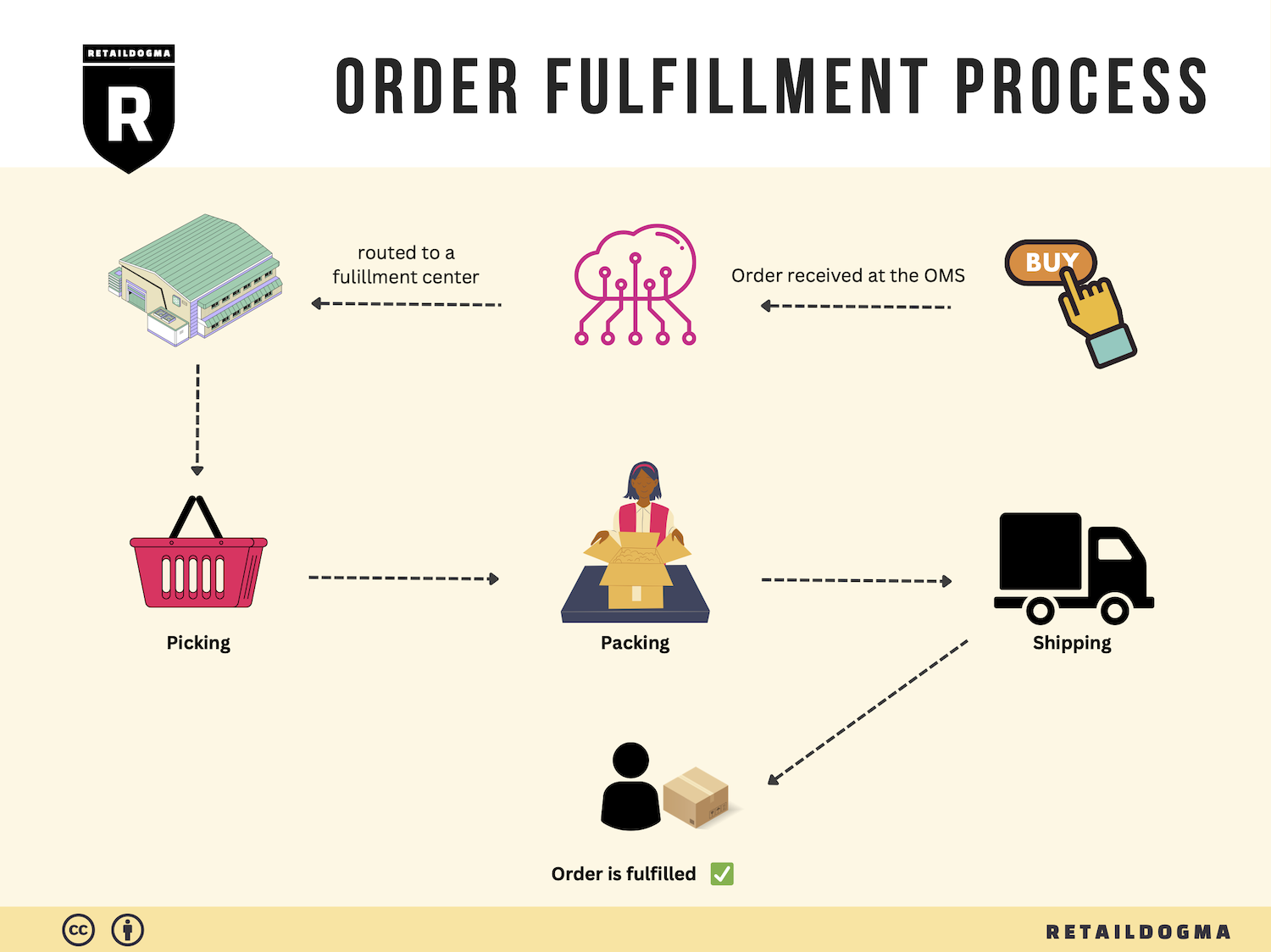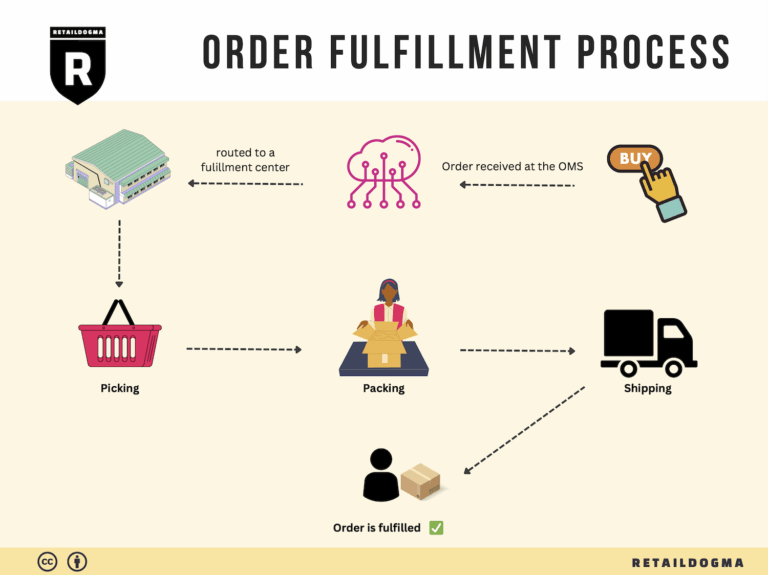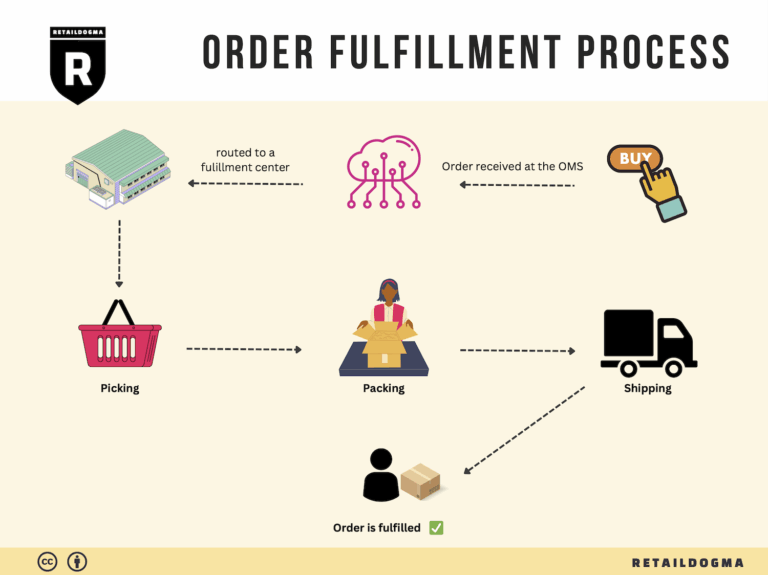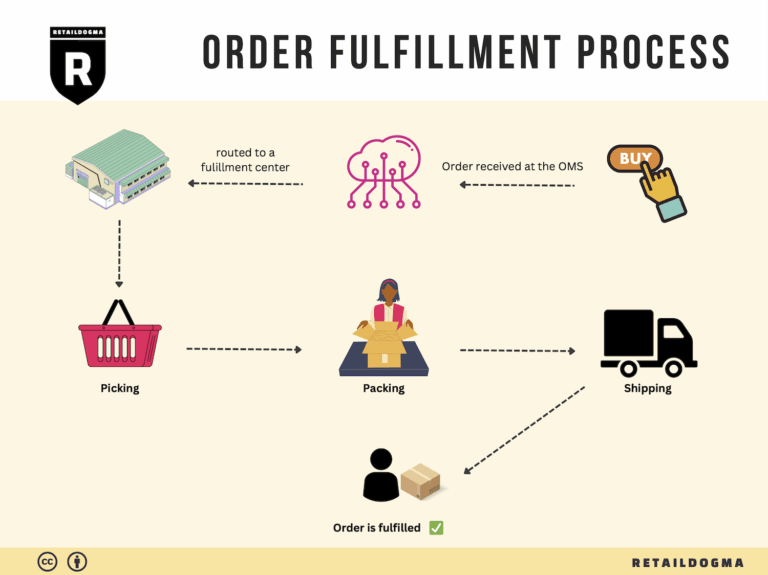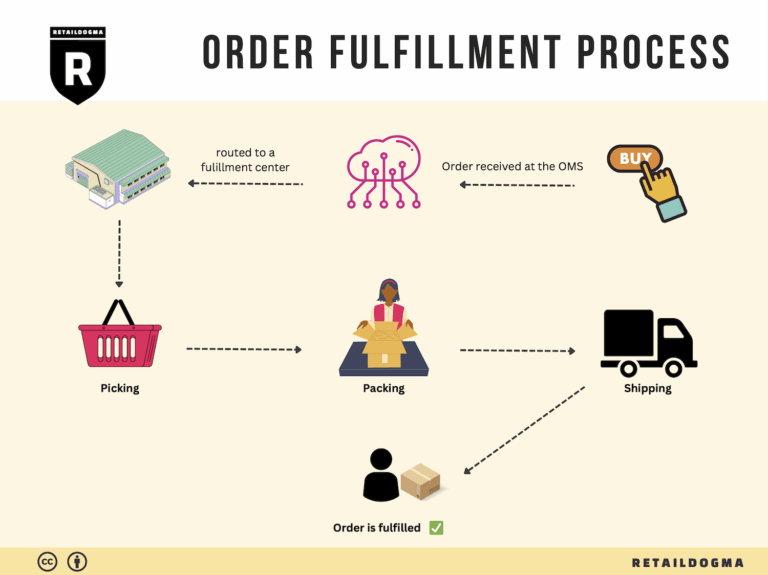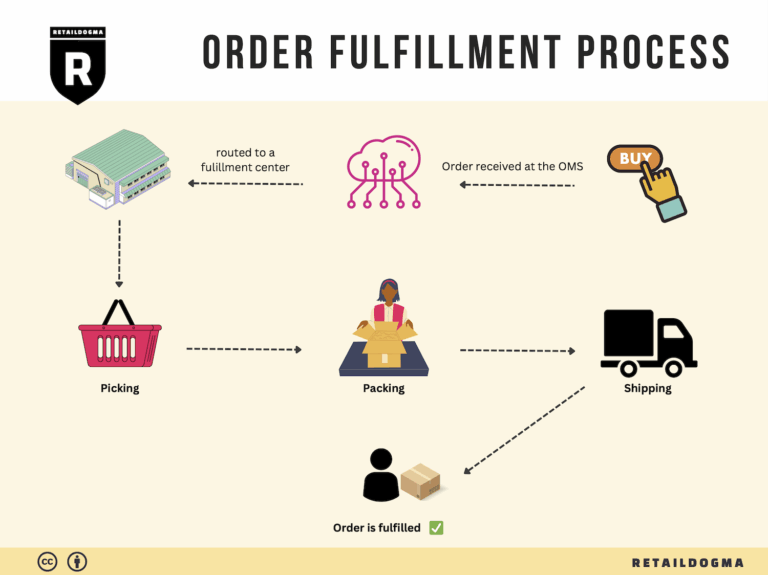How Order Fulfillment Works: A Step-by-Step Guide for Businesses
What is E-commerce Fulfillment? An Introduction for Growing Businesses
Understanding E-commerce Fulfillment
As an e-commerce business owner, you may find yourself in the throes of packing and shipping orders, often feeling overwhelmed by the sheer volume of logistics involved. This stress can become a significant bottleneck, hindering your ability to scale effectively. E-commerce fulfillment, in its simplest form, is the process of getting a product from your inventory into the hands of a customer. It encompasses everything from receiving an order to picking, packing, and shipping the product, as well as handling returns and customer service.
In this guide, we will explore the various models of e-commerce fulfillment, including Third-Party Logistics (3PL) and Fulfillment by Amazon (FBA). Each model offers unique advantages and can suit different business needs. Understanding these options is crucial for making informed decisions about your logistics strategy.
We will also delve into the core services provided by fulfillment partners. These services typically include inventory management, order processing, packing, shipping, and returns management. Knowing what to expect from a fulfillment partner can help you streamline your operations and improve customer satisfaction.
Choosing the right fulfillment partner is a pivotal decision for any growing business. Factors to consider include the partner’s service offerings, scalability, technology integration, and geographical reach. We will guide you through the key criteria to evaluate when selecting a fulfillment provider, ensuring you align your logistics strategy with your growth goals.
Pricing is another critical aspect of e-commerce fulfillment. Understanding the cost structures involved, including storage fees, shipping rates, and any additional service charges, will allow you to budget effectively and maintain healthy profit margins. We will break down the pricing models commonly used in the industry, helping you to make cost-effective decisions.
The goal of this guide is to empower you with the knowledge and tools necessary to make strategic decisions about your e-commerce logistics. By gaining a clearer understanding of fulfillment processes, models, and partners, you can alleviate the stress of order management and focus on scaling your business efficiently. Let’s embark on this journey to enhance your e-commerce fulfillment strategy, ensuring that your operations are as robust and responsive as your customers expect.
What You’ll Learn In This Guide
- What is E-commerce Fulfillment? An Introduction for Growing Businesses
- The Order Fulfillment Process: From ‘Buy’ Button to Customer’s Door
- Comparing Fulfillment Models: In-House vs. 3PL vs. Dropshipping
- A Deep Dive into Amazon FBA: Pros, Cons, and Who It’s For
- Core Services Offered by Fulfillment Centers
- How to Choose a Fulfillment Partner: A 6-Point Checklist
- Understanding Fulfillment Pricing: A Breakdown of Common Fees
- Frequently Asked Questions (FAQs) about Fulfillment
- Conclusion: Is Outsourcing Fulfillment the Right Move for Your Business?
- Important Disclaimer
The Order Fulfillment Process: From ‘Buy’ Button to Customer’s Door
1. Receiving Inventory
The order fulfillment process begins with receiving inventory at Walmart Fulfillment Services (WFS) centers. When sellers partner with WFS, they ship their products to designated fulfillment centers. Upon arrival, the inventory is checked against shipping documents to ensure accuracy. This step is crucial because it verifies that the right products and quantities have been received, preventing future discrepancies.
Key Term: SKU (Stock Keeping Unit)
Each product is assigned a unique SKU, which helps in tracking inventory accurately. Efficient receiving practices minimize the risk of stockouts or overstock situations, laying a solid foundation for subsequent fulfillment steps.
2. Warehouse Storage
Once the inventory is received and verified, it is stored in the fulfillment center. WFS employs advanced storage systems to optimize space and ensure easy access to products. Items are categorized and stored based on various factors such as size, weight, and sales velocity. This organizational strategy is essential for maximizing efficiency and minimizing retrieval time.
Key Term: FIFO (First In, First Out)
WFS often utilizes the FIFO method to manage inventory, ensuring that older stock is sold before newer arrivals. This practice is particularly important for perishable goods and helps maintain product quality, ultimately enhancing customer satisfaction.
3. Order Picking
When a customer clicks the ‘Buy’ button on Walmart.com, the order is processed, and the picking phase begins. WFS generates a pick list that outlines the items and their locations within the warehouse. Trained personnel or automated systems use these lists to quickly locate and retrieve the products.

Key Term: Pick List
The pick list is a critical tool in this step, guiding the order pickers through the warehouse efficiently. Effective picking processes not only speed up order fulfillment but also reduce labor costs and errors, ensuring that customers receive the correct items in a timely manner.
4. Order Packing
After the items are picked, they move to the packing station. Here, the products are carefully packed for shipment. WFS uses standard packaging materials that are designed to protect items during transit while also optimizing space. This step is vital for ensuring that products arrive undamaged at the customer’s doorstep.
Key Term: Packaging Optimization
Packaging optimization involves selecting the right box size and materials to minimize shipping costs while ensuring product safety. This practice can significantly reduce shipping expenses, which is particularly beneficial for e-commerce businesses looking to maximize profit margins.
5. Shipping & Delivery
The final step in the order fulfillment process is shipping the packed orders to customers. WFS leverages its vast logistics network to ensure quick and reliable delivery, often providing 2-day shipping for eligible items. Once the package is dispatched, customers receive tracking information, allowing them to monitor their shipment.
Key Term: Last-Mile Delivery
Last-mile delivery refers to the final leg of the shipping process, where the package is delivered from the fulfillment center to the customer’s address. This stage is critical for customer satisfaction, as it directly impacts the overall shopping experience. By utilizing Walmart’s extensive delivery network, WFS aims to enhance efficiency and reliability in this crucial phase.
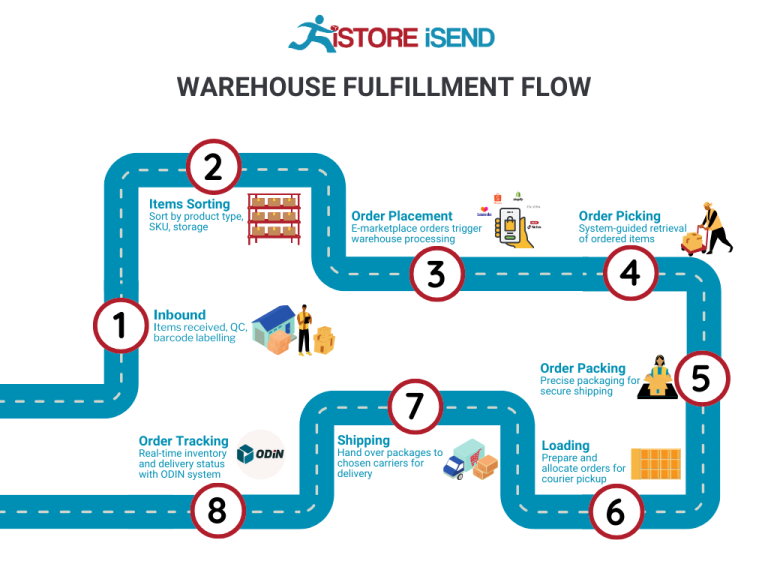
Conclusion
Understanding the order fulfillment process is essential for e-commerce business owners and operations managers aiming to scale their logistics efficiently. Each step—from receiving inventory to shipping and delivery—plays a pivotal role in creating a seamless customer experience. By leveraging Walmart Fulfillment Services, sellers can optimize these processes, enabling growth and enhancing customer satisfaction.
Comparing Fulfillment Models: In-House vs. 3PL vs. Dropshipping
Fulfillment Model Comparison
| Model | Who Handles Inventory | Best For (Business Stage) | Key Advantage | Key Disadvantage |
|---|---|---|---|---|
| In-House Fulfillment | The business itself | Established businesses | Full control over inventory and processes | High overhead costs and resource intensive |
| Third-Party Logistics (3PL) | Third-party logistics provider | Growing businesses | Scalable and cost-effective solutions | Less control over inventory and processes |
| Dropshipping | Supplier or manufacturer | Startups and small businesses | Low startup costs and minimal risk | Lower profit margins and reliance on suppliers |
In-House Fulfillment
In-house fulfillment involves managing all aspects of the storage, picking, packing, and shipping of products within the business itself. This model is best suited for established businesses that have a significant volume of sales and the resources to manage their logistics operations. One of the primary advantages of in-house fulfillment is the complete control it offers over inventory and processes. Businesses can tailor their fulfillment strategies to their specific needs, ensuring that customer expectations are consistently met. However, this control comes at a cost. In-house fulfillment can lead to high overhead costs, as businesses must invest in warehousing, staffing, and technology. Additionally, it can be resource-intensive, diverting focus from core business activities such as marketing and product development.
Third-Party Logistics (3PL)
Third-party logistics (3PL) providers handle the entire fulfillment process on behalf of businesses, including inventory management, warehousing, shipping, and returns. This model is ideal for growing businesses that are looking to scale without the burden of managing logistics internally. A significant advantage of 3PL is its scalability and cost-effectiveness. Businesses can easily adjust their fulfillment capacity according to demand, making it easier to handle seasonal fluctuations or unexpected surges in sales. Moreover, 3PL providers often have established relationships with carriers and logistics networks, which can lead to reduced shipping costs and improved delivery times. However, businesses may experience less control over their inventory and fulfillment processes, which can affect customer experience if not managed properly. Additionally, reliance on a third-party provider can introduce risks related to service quality and responsiveness.
Dropshipping
Dropshipping is a fulfillment model where the retailer does not keep products in stock. Instead, when a customer makes a purchase, the retailer purchases the item from a third party (usually a wholesaler or manufacturer), who then ships it directly to the customer. This model is particularly advantageous for startups and small businesses with limited resources, as it requires low startup costs and minimal risk. Entrepreneurs can offer a wide range of products without the need for significant upfront investment in inventory. However, dropshipping comes with its challenges. Profit margins can be lower compared to other fulfillment methods due to the costs associated with purchasing items from suppliers. Additionally, businesses relying on dropshipping are often at the mercy of their suppliers regarding stock availability, shipping times, and product quality, which can lead to inconsistencies in customer experience.
Conclusion
Choosing the right fulfillment model is crucial for e-commerce businesses looking to scale effectively. In-house fulfillment offers control but at a high cost, while 3PL provides scalability and efficiency at the expense of some control. Dropshipping minimizes risk and upfront costs but can result in lower profit margins and dependency on suppliers. Understanding the strengths and weaknesses of each model will enable business owners to align their fulfillment strategies with their overall business goals, helping them to optimize operations and enhance customer satisfaction. As businesses grow, they may find that a hybrid approach—leveraging elements from multiple fulfillment models—can provide the best balance between control, cost, and flexibility.
A Deep Dive into Amazon FBA: Pros, Cons, and Who It’s For
Understanding Fulfillment by Amazon (FBA)
Fulfillment by Amazon (FBA) is a logistics service that allows e-commerce sellers to store their products in Amazon’s fulfillment centers. When a customer places an order, Amazon takes care of the picking, packing, and shipping of the product, as well as handling customer service and returns. This service is designed to provide sellers with a streamlined process to manage their inventory and shipping logistics, enabling them to focus on growing their business.
How FBA Works
-
Account Setup: Sellers start by creating an Amazon seller account and enrolling in the FBA program. Once enrolled, they can list their products as FBA items.
-
Inventory Shipment: Sellers prepare their products according to Amazon’s guidelines and ship them to designated Amazon fulfillment centers. Each item must be labeled and packaged according to Amazon’s requirements.
-
Storage: Once the products arrive at the fulfillment center, Amazon stores them until they are sold. Sellers can track their inventory through Amazon’s seller dashboard.
-
Order Fulfillment: When a customer orders a product, Amazon picks, packs, and ships the item directly to the customer. This includes providing tracking information and ensuring timely delivery.
-
Customer Service and Returns: Amazon handles all customer inquiries regarding FBA products, as well as managing returns. This alleviates the burden on sellers and enhances the customer experience.

Pros of Fulfillment by Amazon
Prime Eligibility
One of the most significant advantages of using FBA is that products become eligible for Amazon Prime. This increases the visibility of your products and can lead to higher sales, as Prime members tend to prefer items that offer fast shipping options.
Customer Trust
Amazon is a trusted marketplace, and customers often feel more secure purchasing products fulfilled by Amazon. The assurance of quick shipping and reliable customer service can significantly enhance the credibility of your brand.
Multi-Channel Fulfillment
FBA is not limited to Amazon alone. Sellers can use FBA to fulfill orders from their own websites or other platforms. This multi-channel fulfillment capability allows sellers to centralize their inventory and streamline their operations.
Ease of Use
FBA simplifies the logistics of e-commerce. With Amazon handling storage, packing, and shipping, sellers can focus on other aspects of their business, such as marketing and product development.
Scalability
As your business grows, FBA can scale with you. Whether you have a few items or thousands, Amazon’s infrastructure can accommodate your needs without requiring you to invest in your own warehouse space.
Cons of Fulfillment by Amazon
High Fees
While FBA can save time and effort, it comes with a cost. Amazon charges fulfillment fees based on the size and weight of your products, as well as storage fees for inventory stored in their warehouses. These fees can eat into your profit margins if not carefully managed.
Strict Inventory Rules
Amazon has specific requirements for inventory management, including guidelines for packaging, labeling, and shipment preparation. Failure to comply can lead to additional fees or penalties, making it essential for sellers to stay informed about these rules.
Commingling Risks
FBA uses a commingling inventory system, meaning that your products may be stored alongside those of other sellers. This can lead to potential issues if items are lost or damaged, and it may create challenges in tracking returns or managing product quality.
Limited Control
When using FBA, sellers relinquish a degree of control over their fulfillment process. This can be concerning for brands that prioritize personalized customer service or those that have unique packaging requirements.
Inventory Limitations
Amazon may impose limits on the amount of inventory a seller can store in their fulfillment centers, particularly for new sellers or during peak seasons. This can restrict a seller’s ability to scale quickly or meet unexpected demand.
Who is FBA Best For?
Fulfillment by Amazon is ideal for sellers who want to leverage Amazon’s massive customer base and logistics capabilities without the hassle of managing their own fulfillment operations. It is particularly beneficial for:
- Small to Medium-Sized Businesses: Companies looking to scale their operations efficiently without investing heavily in logistics.
- Brands with High Sales Volume: Sellers who anticipate high sales can benefit from the efficiency and reach of FBA.
- E-commerce Entrepreneurs: New sellers seeking to establish credibility and gain access to Prime members will find FBA advantageous.
- Multi-Channel Sellers: Businesses selling on multiple platforms can simplify their logistics by using FBA to fulfill orders across channels.
However, it may not be the best option for sellers with low margins, those who prefer to maintain control over their fulfillment process, or businesses dealing with niche products that require specialized handling. Careful consideration of these factors will help sellers determine if FBA aligns with their overall business strategy.
Core Services Offered by Fulfillment Centers
Inventory Management & Warehousing
Inventory management and warehousing are foundational services provided by fulfillment centers, playing a crucial role in e-commerce operations. This service involves the systematic storage, tracking, and management of products in a warehouse environment.
What It Is:
Fulfillment centers maintain a comprehensive inventory management system that tracks stock levels, orders, sales, and deliveries. This system ensures that businesses know exactly what products are in stock, what needs to be reordered, and when items are available for sale. Additionally, fulfillment centers offer warehousing solutions, providing the physical space necessary to store inventory until it is sold.
Benefits to E-commerce Businesses:
- Optimized Inventory Levels: By utilizing sophisticated inventory management systems, businesses can avoid overstocking or stockouts, ensuring they meet customer demand without tying up excess capital in unsold goods.
- Real-Time Insights: Access to real-time data helps businesses make informed decisions about purchasing and inventory levels, enabling them to respond swiftly to market changes.
- Cost Efficiency: Storing inventory in a fulfillment center can be more cost-effective than maintaining an in-house warehouse, especially for small to medium-sized businesses that may not have the resources to manage logistics independently.
Pick and Pack Services
Pick and pack services are integral to the order fulfillment process, ensuring that products are accurately selected and prepared for shipment to customers.
What It Is:
This service involves the picking of items from inventory based on customer orders and packing them securely for delivery. Fulfillment centers utilize streamlined processes and technology to optimize the picking routes and packing efficiency, reducing the time it takes to fulfill orders.
Benefits to E-commerce Businesses:
- Speed and Accuracy: Efficient pick and pack processes help businesses fulfill orders quickly and accurately, enhancing customer satisfaction. This is particularly important during peak shopping seasons when demand surges.
- Scalability: As a business grows, its order volume typically increases. Fulfillment centers can easily scale their pick and pack operations to handle larger volumes without compromising service quality.
- Reduced Labor Costs: Outsourcing these services to fulfillment centers allows e-commerce businesses to focus on core activities like marketing and product development while reducing the labor costs associated with managing fulfillment in-house.
Kitting and Assembly
Kitting and assembly services are specialized offerings that allow businesses to combine multiple items into a single package or product, enhancing the customer experience and product presentation.
What It Is:
Kitting involves grouping different products together into a single kit for sale, while assembly refers to the process of creating a finished product from individual components. Fulfillment centers can handle both processes, ensuring that kits are assembled accurately and efficiently.
Benefits to E-commerce Businesses:
- Enhanced Product Offerings: Kitting allows businesses to offer bundled products that provide greater value to customers, increasing average order value and potentially boosting sales.
- Streamlined Operations: By outsourcing kitting and assembly to fulfillment centers, businesses can streamline their operations, reducing the complexity and time associated with managing these processes internally.
- Improved Customer Satisfaction: Offering well-packaged kits or assembled products can enhance the customer experience, leading to higher satisfaction and repeat purchases.
Returns Management (Reverse Logistics)
Returns management, often referred to as reverse logistics, is a critical service for e-commerce businesses, addressing the challenges of product returns and exchanges.
What It Is:
This service encompasses the processes involved in handling returned products, including their inspection, restocking, and, if necessary, refurbishment or disposal. Fulfillment centers typically provide seamless solutions for managing returns, making it easier for customers to return items and for businesses to process those returns efficiently.
Benefits to E-commerce Businesses:
- Customer Trust and Loyalty: An effective returns management process builds customer trust. When customers know they can easily return items, they are more likely to make purchases, resulting in increased sales.
- Operational Efficiency: Fulfillment centers streamline the returns process, reducing the time and resources businesses need to allocate to handling returns. This efficiency allows companies to focus on growth and customer engagement rather than logistical challenges.
- Data Insights: Returns management provides valuable insights into customer preferences and product performance. Understanding why items are returned can inform product development and marketing strategies, ultimately leading to improved offerings and reduced return rates.
In conclusion, partnering with a fulfillment center can significantly enhance an e-commerce business’s operational efficiency and customer satisfaction. By leveraging services like inventory management, pick and pack, kitting, and returns management, businesses can scale effectively, streamline their logistics, and focus on growth.
How to Choose a Fulfillment Partner: A 6-Point Checklist
Location & Warehouse Network
Importance:
The geographical location of your fulfillment partner’s warehouses plays a crucial role in shipping efficiency and cost. Having warehouses strategically located near your customer base can significantly reduce shipping times and expenses, which is essential for maintaining customer satisfaction and loyalty.
Questions to Ask:
– Where are your fulfillment centers located, and how does that align with my target market?
– Can you provide coverage maps showing your shipping capabilities?
– Do you have plans for expanding your warehouse network in the future?
Technology & Integrations
Importance:
In the fast-paced world of e-commerce, leveraging technology for order management, inventory tracking, and shipping is vital. A partner with robust technological capabilities can provide real-time tracking, automated updates, and seamless integration with your existing systems, enhancing operational efficiency.
Questions to Ask:
– What technology platforms do you use for order processing and inventory management?
– Can your system integrate with my e-commerce platform (e.g., Shopify, WooCommerce, Walmart Marketplace)?
– Do you offer API access for custom integrations, and how user-friendly is your software?
Specializations (e.g., Cold Storage, Oversized Items)
Importance:
Different products require different handling and storage solutions. If your business deals with perishable goods, oversized items, or specialized products, it’s critical to partner with a fulfillment provider that has the necessary expertise and facilities.
Questions to Ask:
– What types of products do you specialize in handling?
– Do you offer specific services for items that require temperature control, fragile items, or oversized goods?
– Can you accommodate my product’s unique storage and shipping requirements?
Scalability & Capacity
Importance:
As your business grows, your fulfillment needs will evolve. A suitable partner must have the capacity to scale operations in line with your growth. This includes managing increased inventory, order volume, and seasonal fluctuations without compromising service quality.
Questions to Ask:
– How do you handle peak seasons or unexpected surges in demand?
– What is your capacity for scaling up operations, and how quickly can you do so?
– Are there any limitations on the volume of inventory I can store with you?
Pricing and Contracts
Importance:
Understanding the pricing structure and contract terms is essential for budgeting and financial planning. A transparent pricing model without hidden fees will help you avoid unexpected costs that could impact your margins.
Questions to Ask:
– What is your pricing model (e.g., per item, weight-based, monthly fees)?
– Are there any additional costs for services such as returns, packaging, or custom labeling?
– Can you provide a sample contract, and what are your terms regarding contract length and cancellation?
Customer Support & Reviews
Importance:
Responsive and knowledgeable customer support is critical, especially during high-pressure times such as product launches or peak sales seasons. Additionally, checking reviews from other clients can provide insights into the reliability and performance of a potential partner.
Questions to Ask:
– What customer support channels do you offer (e.g., phone, email, chat)?
– What are your typical response times for customer inquiries or issues?
– Can you provide references or case studies from current clients in my industry?
Conclusion
Choosing the right fulfillment partner is a critical decision that can impact your business’s operational efficiency and customer satisfaction. By following this checklist, you can ensure that you select a partner who meets your specific needs and helps you scale effectively. Prioritize your requirements based on your business model and product types, and don’t hesitate to conduct thorough due diligence before making your final choice.
Understanding Fulfillment Pricing: A Breakdown of Common Fees
Initial Setup Fees
When engaging with a fulfillment service like Walmart Fulfillment Services (WFS), initial setup fees are a common consideration. Fortunately, WFS typically does not charge any setup fees, making it financially accessible for new sellers. However, it’s crucial to note that some third-party fulfillment providers may impose one-time fees for account setup, integration of your inventory management systems, or training on their platform. To ensure clarity, always review the specific terms when signing up for any fulfillment service, and inquire about any potential hidden fees that might arise during the onboarding process.
Receiving Fees
Receiving fees are charges incurred when your inventory arrives at the fulfillment center. These fees cover the costs associated with unloading, inspecting, and storing your items. In the case of WFS, receiving fees are generally straightforward, calculated based on the number of units received. For example, if you send 100 units of a product, you may be charged a fixed rate per unit for the receiving process. Understanding this fee structure is vital, as it impacts your overall cost of goods sold (COGS) and should be factored into your pricing strategy.
Storage Fees (per pallet/bin)
Storage fees are charged for the space your inventory occupies within the fulfillment center. These fees can vary based on the size and weight of the items, as well as the duration they remain in storage. For WFS, storage fees are typically calculated on a per-pallet or per-bin basis. This means if your products take up more space, you will incur higher storage costs. It’s beneficial to optimize your inventory levels to minimize these fees. Regularly analyzing your sales trends can help you maintain an efficient inventory flow, reducing unnecessary storage costs.
Pick & Pack Fees (per item/order)
Pick and pack fees are charged each time an order is processed, covering the costs of retrieving items from storage, packing them for shipment, and preparing them for delivery. At WFS, these fees are often calculated on a per-item or per-order basis. For instance, if an order contains three different items, you may incur a fee for each item picked and packed. Understanding this fee structure allows you to assess your pricing model effectively. To manage these costs, consider bundling products or promoting higher-value items that can justify the additional fees.
Shipping Fees
Shipping fees cover the cost of delivering the package to the customer. These fees can vary based on several factors, including the shipping method chosen, the weight of the package, and the destination. WFS typically offers competitive shipping rates, often lower than other fulfillment providers, which can significantly impact your profit margins. When calculating shipping fees, it’s essential to consider how they will be passed on to customers. Offering free shipping can increase sales but may require you to absorb these costs. Utilizing WFS’s 2-day shipping option can also enhance customer satisfaction and drive sales, as customers value quick delivery times.
Tips for Getting an Accurate Quote
-
Evaluate Your Inventory Needs: Before reaching out for a quote, assess your inventory levels and turnover rates. This understanding will help you gauge potential storage and receiving fees accurately.
-
Clarify Fee Structures: Ask specific questions regarding how each fee is calculated. Understanding the nuances of receiving, storage, pick & pack, and shipping fees will help you build a more accurate cost model.
-
Request a Breakdown: When you receive a quote, request a detailed breakdown of all potential fees. This transparency will help you identify any areas where you can optimize costs.
-
Consider Volume Discounts: If you anticipate high sales volume, inquire about bulk shipping or storage discounts. Many fulfillment providers, including WFS, offer reduced rates for larger volumes.
-
Regularly Review Costs: Once you begin using a fulfillment service, regularly review your fees and overall fulfillment costs. This practice can help you identify trends and opportunities for savings.
By understanding the various fulfillment pricing models and following these tips, you can effectively manage your costs and enhance your e-commerce operations.
Frequently Asked Questions (FAQs) about Fulfillment
1. What is Walmart Fulfillment Services (WFS)?
Walmart Fulfillment Services (WFS) is an end-to-end logistics solution that allows sellers on Walmart Marketplace to leverage Walmart’s extensive supply chain capabilities. It handles the storage, picking, packing, and shipping of products directly to customers, as well as managing customer service and returns.
2. How does WFS work?
To use WFS, sellers need to create a Marketplace seller account and send their inventory to Walmart’s fulfillment centers. Once received, products are listed for sale on Walmart.com, and when a customer makes a purchase, WFS takes care of the entire fulfillment process, including delivery and returns.
3. What are the costs associated with WFS?
WFS offers a competitive pricing structure, averaging about 15% less than other marketplace fulfillment providers. Sellers only pay for the storage, picking, packing, and shipping of items, with no setup or hidden fees. Costs can vary based on the volume and type of products being fulfilled.
4. Are there any inventory requirements to use WFS?
There are no minimum inventory requirements to start using WFS. However, it is recommended that sellers set up at least 50 items with consistent inventory replenishment to optimize their potential for growth and visibility on Walmart.com.
5. What types of products can I ship using WFS?
WFS can handle items weighing up to 500 pounds and measuring up to 120″ x 105″ x 93″ (including packaging). However, it does not accept regulated or perishable items that require temperature control. Sellers must also ensure that their products comply with Walmart’s prohibited products policies.
6. Can I use WFS for items not sold on Walmart.com?
Yes, through Walmart’s Multichannel Solutions program, sellers can fulfill orders from other channels using WFS. This allows for centralized inventory management across different sales platforms.
7. How can I improve my sales performance with WFS?
To accelerate revenue growth with WFS, sellers should competitively price their items, ensure high-quality product listings, maintain adequate inventory levels, and consider participating in Walmart Sponsored Search for increased visibility.
8. What is the difference between a warehouse and a fulfillment center?
A warehouse is primarily used for storage of goods, while a fulfillment center is designed to process and ship orders directly to customers. Fulfillment centers are equipped for rapid order processing, packing, and shipping, which enhances customer satisfaction.
9. What is a Third-Party Logistics Provider (3PL)?
A Third-Party Logistics Provider (3PL) is a service that allows businesses to outsource their logistics and supply chain management. This can include warehousing, inventory management, transportation, and fulfillment services. WFS acts as a 3PL for sellers on Walmart Marketplace.
10. How does WFS handle returns?
WFS simplifies the returns process by allowing customers to return items either through Walmart stores or by mail. This omnichannel approach enhances customer experience and makes it easier for sellers to manage returns efficiently.
By understanding these key aspects of Walmart Fulfillment Services, e-commerce business owners can make informed decisions that will streamline their operations and enhance customer satisfaction.
Conclusion: Is Outsourcing Fulfillment the Right Move for Your Business?
Evaluating the Benefits of Outsourcing Fulfillment
Outsourcing your fulfillment process can significantly transform your e-commerce operations, offering benefits that are hard to overlook. By leveraging a fulfillment service like Walmart Fulfillment Services (WFS), businesses can save valuable time and resources, allowing them to focus on strategic growth initiatives rather than the complexities of logistics. With WFS, you gain access to a robust supply chain network that offers two-day shipping, thus enhancing customer satisfaction and potentially boosting sales. Sellers report an average growth of 50% in Gross Merchandise Volume (GMV) when utilizing WFS, demonstrating the tangible impact of efficient fulfillment.
Scalability is another compelling reason to consider outsourcing. As your business grows, so do your shipping and inventory management needs. With no minimum or maximum inventory requirements, WFS allows you to adjust your stock levels flexibly based on demand. This adaptability is crucial for businesses looking to scale without the burden of managing logistics in-house.
Moreover, partnering with an experienced fulfillment provider brings expertise that can streamline your operations. WFS handles all aspects of fulfillment—from storage to customer service and returns—ensuring that you benefit from their industry knowledge and best practices.
However, choosing the right fulfillment partner is vital for your growth trajectory. It’s essential to assess whether a partnership aligns with your business goals and customer expectations.
Take Action
Now is the time to audit your current shipping and fulfillment processes. Evaluate your efficiency, costs, and customer satisfaction levels. Are you maximizing your potential? If not, consider whether a fulfillment partner like Walmart Fulfillment Services could be the strategic move that elevates your business to new heights. Explore your options and take the first step towards a more streamlined, scalable, and successful e-commerce operation.
Important Disclaimer
⚠️ Important Disclaimer
The information in this guide is for educational purposes. Fulfillment services, pricing, and platform features change frequently. Always conduct your own due diligence and consult with providers directly before making business decisions.
